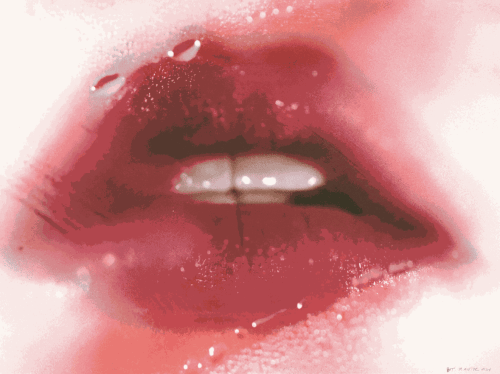Marilyn Minter is a boundary-pushing contemporary artist known for her bold depictions of beauty, glamour, and the female body. Born in 1948 in Shreveport, Louisiana, and raised in Florida, Minter was deeply influenced by her early experiences with her mother, who suffered from addiction and mental illness. These formative years exposed her to the contradictions of femininity and the pain behind idealized beauty—an experience that continues to echo through her artwork. She studied art at the University of Florida before completing her MFA at Syracuse University in 1972, where she first began experimenting with photography, laying the groundwork for her unique blend of image-making that would later define her career.
Minter’s practice is rooted in the tension between realism and fantasy. She is best known for her large-scale, hyperrealistic paintings and photographs that zoom in on the sensual details of the body—glossy lips, feet in high heels, and eyeshadowed lids are rendered in startling clarity. Her subjects often appear drenched in glitter, sweat, or condensation, resulting in seductive yet unsettling compositions. Rather than presenting beauty as flawless, Minter highlights its messiness and maintenance, capturing the friction between desire and disgust. Her technique seduces the viewer while simultaneously challenging them to consider what lies beneath the surface.
Photorealism, a core element of Minter's practice, involves painstakingly reproducing photographic imagery in painting. However, Minter’s approach is far from clinical. She begins with high-resolution photography, often staged in collaboration with stylists and makeup artists. These photographs are then digitally manipulated and projected onto aluminum panels, where she meticulously paints with enamel to achieve a heightened, almost surreal realism. Unlike traditional photorealism that strives for neutrality, Minter’s version is lush, visceral, and emotionally charged. Her painted surfaces shimmer with detail, inviting tactile curiosity while confronting the viewer with the imperfections often hidden by mass media.
Throughout her career, Minter has challenged the traditional boundaries of fine art, fashion, and advertising. Her work frequently borrows the language of commercial imagery—sparkle, gloss, and polish—but reclaims it through a feminist lens. A key example is her video Green Pink Caviar (2009), which features close-ups of a tongue licking glittery substances off glass. The video is both seductive and grotesque, a perfect encapsulation of Minter’s aesthetic. This push-pull dynamic—between attraction and repulsion, fantasy and reality—is at the heart of her work.
Minter rose to prominence during a period when feminist artists were pushing back against the male gaze and the rigid standards of beauty perpetuated by mass media. Her work stood out for its unapologetic sensuality and refusal to sanitize female sexuality. Rather than rejecting glamour, Minter embraced it—only to expose the labor, distortion, and fantasy that constructs it. Her images show the effort behind looking effortless, whether it’s smeared makeup, fogged-up glass, or lipstick-stained teeth. In doing so, she reclaims the female body from objectification and reveals it as a site of power, complexity, and resistance.
Her artistic influence extends beyond the studio. Minter has been a vocal advocate for women's rights and reproductive freedom, using her platform and art to raise awareness and support for organizations like Planned Parenthood. She has also mentored younger generations of artists, especially women navigating the art world’s double standards. Her blend of activism and artistry demonstrates how visual culture can be a tool for both pleasure and political resistance. By refusing to separate aesthetics from ethics, Minter reaffirms the role of artists as agents of change.
Internationally, Minter’s work has been exhibited in major museums including the Museum of Modern Art, the San Francisco Museum of Modern Art, and the Brooklyn Museum. Her appeal spans generations and disciplines, resonating with both fine art collectors and pop culture audiences. Her work has been featured in major campaigns and collaborations, blurring the lines between commercial and conceptual. Through these avenues, Minter brings her feminist message to a global stage, challenging viewers around the world to reconsider how they consume images of beauty and power.
Marilyn Minter’s body of work continues to evolve, but her core concerns remain constant: the politics of desire, the construction of femininity, and the cost of perfection. Her photorealistic technique and sensual surfaces seduce the viewer only to implicate them in the mechanisms of visual consumption. In a world saturated with filtered, flawless imagery, Minter’s work offers an unflinching look at what lies beneath—raw, imperfect, and deeply human. Her legacy is one of artistic rigor and cultural critique, situating her as a vital voice in contemporary art and feminist discourse.

